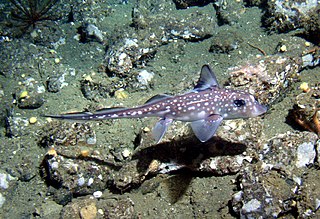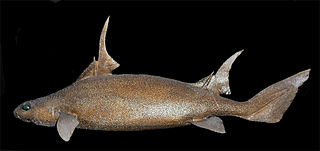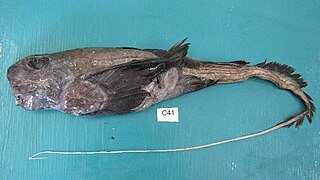
Chimaeras are cartilaginous fish in the order Chimaeriformes, known informally as ghost sharks, rat fish, spookfish, or rabbit fish; the last three names are not to be confused with rattails, Opisthoproctidae, or Siganidae, respectively.

The black dogfish is a species of dogfish shark in the family Etmopteridae. It is common over the outer continental shelf and continental slope at depths of 180–2,250 m (590–7,380 ft). Females generally inhabit deeper water than males, and depending on the region, smaller sharks may occur at different depths than larger ones. This species is distributed widely in the Atlantic Ocean, from Greenland and Iceland to Virginia and West Africa in the north, and off southwestern Africa and Argentina in the south. The largest member of its family, the black dogfish, typically measures 60–75 cm (24–30 in) long. It has a stocky, dark brown body that is darker below than above, and bears scattered, minute bioluminescent organs. Its two dorsal fins are preceded by stout spines, and the anal fin is absent.

The kitefin shark or seal shark is a species of squaliform shark in the family Dalatiidae, and the type species in its genus. It is found sporadically around the world, usually close to the sea floor at depths of 200–600 m (660–1,970 ft). With a sizable oil-filled liver to maintain neutral buoyancy, this shark is able to cruise slowly through the water while expending little energy. The kitefin shark, the largest luminous vertebrate on record, has a slender body with a very short, blunt snout, large eyes, and thick lips. Its teeth are highly differentiated between the upper and lower jaws, with the upper teeth small and narrow and the lower teeth large, triangular, and serrated. Its typical length is 1.0–1.4 m (3.3–4.6 ft), though examples as long as 5.9 ft (180 cm) have been encountered.
The pale ghost shark is a shortnose chimaera of the family Chimaeridae. It is endemic to New Zealand waters.

The night shark is a species of requiem shark, in the family Carcharhinidae, found in the temperate and tropical waters of the Atlantic Ocean. An inhabitant of the outer continental shelf and upper continental slope, this shark most commonly occurs at depths of 50–600 m (160–1,970 ft) and conducts a diel vertical migration, spending the day in deeper water and moving into shallower waters at night. Off northeastern Brazil, large numbers congregate around seamounts of varying depths. A slender, streamlined species, the night shark typically reaches a length of 2 m (6.6 ft). It can be identified by its long, pointed snout and large, green eyes, and is dark grayish blue or brown above and white below.

The Portuguese dogfish or Portuguese shark, is a species of sleeper shark of the family Somniosidae. This globally distributed species has been reported down to a depth of 3,675 m (12,057 ft), making it the deepest-living shark known. It inhabits lower continental slopes and abyssal plains, usually staying near the bottom. Stocky and dark brown in color, the Portuguese dogfish can be distinguished from similar-looking species by the small spines in front of its dorsal fins. Its dermal denticles are also unusual, resembling the scales of a bony fish. This species typically reaches 0.9–1 m (3.0–3.3 ft) in length; sharks in the Mediterranean Sea are much smaller and have distinct depth and food preferences.

The sailfin roughshark is a species of dogfish shark in the family Oxynotidae, found in the eastern North Atlantic from Scotland to Senegal between latitudes 61°N and 11°N, at depths of between 265 and 720 m. Its length is up to 1.2 m (3.9 ft).

The African chimaera is a species of fish in the family Chimaeridae found near Kenya, Mozambique, Namibia, and South Africa. Its natural habitat is deep-waters up to the depth of 750 m Eight species of chimaera are found in the southern African region, representing the three families and all six genera.

Hydrolagus is a genus of fish in the family Chimaeridae found in the Atlantic, Indian and Pacific Oceans.

The pointy-nosed blue chimaera, also known as the pointy-nosed blue ratfish, Ray Troll's chimaera or abyssal ghostshark, is a species of deep-sea fish in the family Chimaeridae.

The Chimaeridae, or short-nosed chimaeras, are a family of cartilaginous fish.

The large-eyed rabbitfish is a species of fish in the family Chimaeridae. It is found in several areas of the Atlantic Ocean and within the Mediterranean Sea.
The Eastern Pacific black ghostshark is a species of fish in the family Chimaeridae. Despite its name, it does not belong to the clade Selachii used for the modern classification of sharks. It is, however, distantly related to the sharks in the sense that both are Chondrichthyes.
The whitefin chimaera is a species of fish in the family Chimaeridae. It is found in the Indian Ocean to the NW of Australia, with a restricted distribution. Chimaera argiloba inhabits marine waters from a depth range of 370–520 m. It is abundant within its range.
The longspine chimaera is a chimaera species in the family Chimaeridae. It is found off of the eastern and western coasts of Australia, and lives in tropical and temperate waters 435–1,300 meters deep. Males and females grow to a maximum total length of 93.9 and 103.4 centimeters, respectively, and are brown in color.
The cape chimaera is a chimaera species in the family Chimaeridae, which lives in South Africa and Namibia.
The marbled ghostshark is a chimaera species in the family Chimaeridae, which lives in waters off the eastern coast of Australia.

The whitespot ghost shark is a chimaera species in the family Chimaeridae, which lives in parts of the Galápagos Islands in the southeast Pacific Ocean. It lives in waters with steep slopes and boulders and grows to a total length of around 40–50 cm (16–20 in).
The Galápagos ghostshark is a chimaera species in the family Chimaeridae, likely endemic to the Galápagos Islands. It was discovered by John E. McCosker in 1995 and described in 2006, scientifically named in honor of McCosker. This chimaera has a brown compressed, elongate body. The holotype and paratype of the species, both juvenile females, had a total length of 38.1 centimetres (15.0 in) and 22.7 centimetres (8.9 in), respectively. It lives in rocky habitats close to the sea floor, in waters about 395–510 metres (1,296–1,673 ft) deep. It is listed as least concern on the IUCN Red List.
Hydrolagus erithacus, or Robin's ghostshark, is a species of fish in the family Chimaeridae. It is found in the southeastern Atlantic and southwestern Indian oceans.












